Tips for improving the efficacy of ethephon PGR spray applications
Air temperature at application and carrier water alkalinity can influence the efficacy of your ethephon plant growth regulator (PGR) applications.

Plant growth regulators (PGRs) are commonly applied as foliar sprays, substrate drenches, liner dips, or bulb, tuber and rhizome dips/soaks. Using PGRs on greenhouse crops assists growers in producing uniform and compact plants that can be easily packaged, shipped and marketed to consumers. The majority of the PGRs (e.g., ancymidol, chlormequat chloride, daminozide, flurprimidol, paclobutrazol, or uniconazole) used by greenhouse growers suppress stem elongation (extension growth) by inhibiting the biosynthesis of gibberellins (GAs), which are plant hormones that regulate growth and stem elongation.
In contrast, ethephon (2-chloroethyl; phosphonic acid) is a PGR that has multiple uses as it releases ethylene—another plant hormone responsible for ripening and senescence—upon application. It can be used to suppress stem elongation; increase stem diameter; reduce apical dominance, causing an increase in branching and lateral growth; and induce abscission (abortion) of flowers and flower buds (Photo 1).
For example, if applied during propagation, it can set the “biological clock” of crops with sporadic or non-uniform flowering, such as New Guinea impatiens, to zero (Photo 2) by causing flower and flower bud abortion. Additionally, some growers use it to increase branching and reduce stem elongation of petunia (Photo 3).
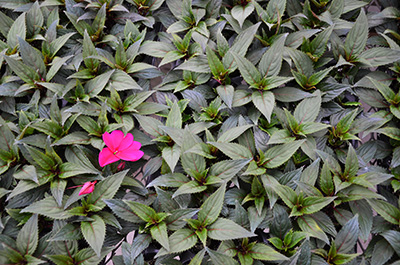
Photo 2. Premature and non-uniform flowering of New Guinea impatiens in propagation. Photo by Roberto Lopez, MSU.
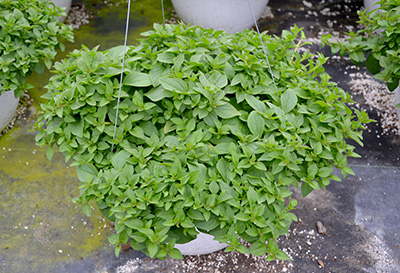
Photo 3. Increased branching, reduced internode elongation, and flower bud abortion on petunia treated with ethephon. Photo by Roberto Lopez, MSU.
Ethephon (e.g., Florel, 3.9 percent active ingredient; or Collate, 21.7 percent active ingredient) sprays are typically applied to greenhouse crops one to two weeks after transplant and applications can be repeated one to two weeks later. Many factors influence its efficacy including the rate, volume, use of a surfactant, spray solution pH, substrate moisture and greenhouse humidity.
The following will teach you how to optimize your ethephon spray applications by monitoring and adjusting two often overlooked cultural and environmental factors that can influence efficacy.
Water alkalinity and pH
Similar to most greenhouse chemicals and PGRs, ethephon is often applied as a liquid (spray). As ethephon changes to ethylene, it changes from a liquid to gaseous state. If ethephon breaks down into ethylene outside the plant, most of the chemical will be lost in the air. Therefore, we want it to be absorbed by the plant before it breaks down into ethylene. Ethephon breaks down into ethylene quicker as pH increases. This means the goal is to keep the pH of the spray solution after adding ethephon to your carrier water within the recommended range of 4 to 5. This is normally not a problem because ethephon is naturally acidic. However, if you have water with high alkalinity, the pH may not decrease enough to fall in the recommended range and you may need to add a buffering agent such as an acid (sulfuric acid or adjuvant, pHase5 or Indicate 5) to lower the pH.
Ethephon is naturally acidic and as the concentration increases, the solution pH will decrease. As carrier water alkalinity decreases, solution pH also decreases (Photo 4). The ultimate goal is to keep the spray solution pH between 4 and 5. However, growers with very pure water (low alkalinity) may need to add a different buffering agent that will keep the spray solution water pH from dropping too low (pH less than 3.0).
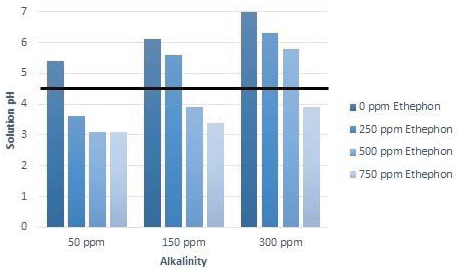
Photo 4. Influence of carrier water alkalinity and ethephon concentration on spray solution pH. Black line represents the recommend water carrier pH 4.5.
In a recent study at Michigan State University, we applied ethephon using three carrier water alkalinities (50, 150 and 300 ppm CaCO3) and four ethephon (Collate, Fine Americas, Inc., Walnut Creek, CA; 0, 250, 500 and 750 ppm) concentrations to ivy geranium, petunia and verbena. We found that extension growth deceased as the carrier water alkalinity decreased and ethephon concentration increased (Photo 5).
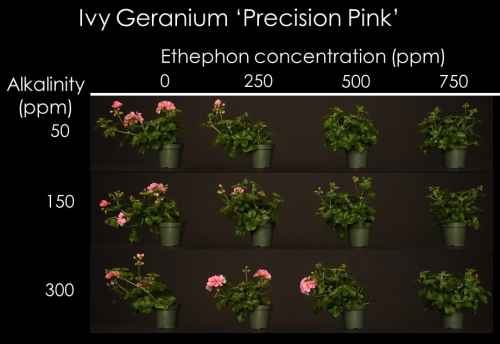
Photo 5. Influence of carrier water alkalinity and ethephon concentration on branching and flowering of ivy geranium. Photo by Kellie Walters.
Therefore, MSU Extension recommends you check the alkalinity of your carrier water before applying ethephon. This can be done by sending a water sample to your preferred lab or you can test your water with a hand-held alkalinity meter (Photo 6) and then make the necessary adjustments as described above. Next, add ethephon and check the pH of your spray solution with a hand-held pH meter to ensure it is between 4 and 5.

Photo 6. Portable and hand-held alkalinity meter that can be used in the greenhouse to determine your carrier water alkalinity. Photo by Kellie Walters.
Air temperature at application
We have also determined that air temperature at the time of chemical application can also influence the efficacy of ethephon. As air temperature increases, the rate of ethylene release from ethephon increases, theoretically reducing efficacy. From our research, we have found adequate ethephon efficacy when the air temperature at application was between 57 to 73 degrees Fahrenheit. However, when temperatures increased to 79 F, ethephon had little to no effect on extension growth, promoting branching or flower bud abortion (Photo 7).
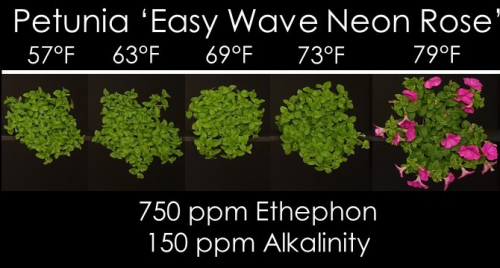
Photo 7. Influence of air temperature at application on the efficacy of a 750 ppm ethephon spray on petunia. Photo by Kellie Walters.
Take-home message
If you have high water alkalinity, use a buffer or adjuvant to lower the alkalinity of your water before mixing your spray solution and ultimately the spray solution pH. Consider making your ethephon spray application on a cloudy day, early in the morning or in the evening when greenhouse temperatures are below 79 F.
Acknowledgments. This material is based upon work supported by Fine Americas, Inc., the Western Michigan Greenhouse Association, the Metro Detroit Flower Growers Association and Ball Horticultural Co.
Dr. Lopez’s work is funded in part by MSU‘s AgBioResearch.



 Print
Print Email
Email


